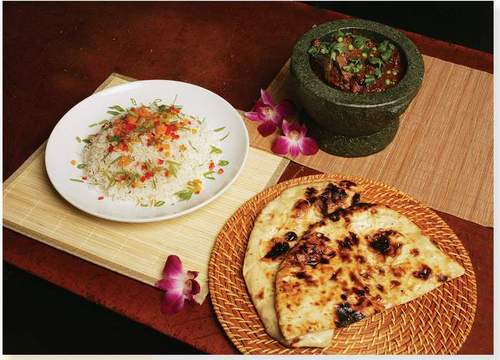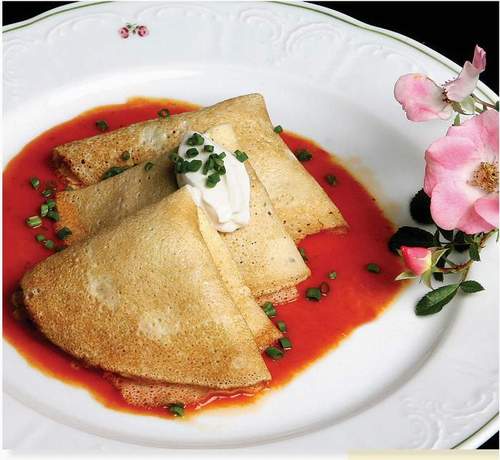Mission: Cook! (23 page)

First,
make the masala: Grind the ginger, garlic, mace, nutmeg, cloves, peppercorns, almonds, the two cardamom pods, saffron, and poppy seeds, adding them one at a time through the feeder tube of a food processor, then adding a little water at a time to make a fine paste.
Heat the ghee or clarified butter in a wok and fry the onion until browned. Add the three cardamom pods, and stir in the masala paste. Fry for 2 minutes, taking care not to burn the mixture. Add the turmeric, chili powder, cumin, paprika, and coriander, and fry for 2 minutes more. Stir in the yogurt and tomatoes. Stir in the lamb and a little salt.
Cover and cook over a gentle heat for 40 to 50 minutes, sprinkling with a little water if necessary. Serve garnished with chopped cilantro leaves.
A Note on Peeling Fresh Ginger
Peeling fresh ginger is the easiest thing in the world. You don't even need a knife. Simply take a teaspoon, flip it so it's “tip down” to the surface of the gingerroot, and scrape the covering off.
A Note on Clarified Butter
The use of clarified butter enables you to cook at higher temperatures than you otherwise would be able to do with butter. This is because the “clarification” process separates out the milk solids, which have a lower burning point than the butterfat. To clarify your own butter, take whole butter in an amount that is about one-quarter more than what is called for in clarified form. Melt it over low heat and scoop out the foam that rises. Then, spoon off the clear butterfat to a clean bowl or container, being careful not to disturb the water or milk solids at the bottom. Voilà ! The clear portion is clarified butter. (Ghee is clarified butter that is heated a little longer to impart a nutty flavor.)
A Note on Mace “Blades”
This is the term for the delicate outer covering of the fruit, which yields both mace (the fruit portion) and nutmeg (the nutlike seed portion).
MAKES
12
CHAPATI
8 ounces (1 cup) all-purpose or whole-grain flour
1½ teaspoons salt
4 teaspoons melted ghee, or unsalted clarified butter
7 ounces water, approximately
2 onions, very finely chopped
2 fresh green chiles, very finely chopped
PREPARATION AND COOKING TIME
Prep and kneading time
10 to 15 minutes
Dough resting time
30 minutes
Assembly/cooking time
15 to 20 minutes
Total time
about 1 hour
EQUIPMENT
Tongs with rubberized handles (so you won't get burned)
A type of bread eaten in South Asia.
Sift
the flour and 1 teaspoon of the salt into a large mixing bowl. Make a well in the center and add 2 teaspoons of the melted ghee or clarified butter, together with enough water to make a supple dough. Knead for 10 minutes, then cover with a damp tea towel, and leave in a cool place for 30 minutes.
Mix the onions and chiles with the remaining ½ teaspoon salt. Place in a sieve and squeeze out any liquid.
Knead the dough again, then divide into 12 pieces. Roll out each piece on a lightly floured surface into a thin round. Put a little of the onion and chile mixture in the center, fold the dough over, and form into a ball, then roll out carefully into a round.
Using the remaining 2 teaspoons ghee or clarified butter, as needed, to grease a skillet; brown the rounds on the burner at high heat on both sides. The rounds should puff up. Use tongs to remove them safely from the skillet.
A Note on Traditional Chapati Preparation
Traditionally, chapati is held briefly over an open flame so that it will puff up.
A Note on Clarified Butter
Do you remember when you were a little kid and you saw those tiny pots that your mother or grandmother had in the cupboardâor you even saw them for sale in a storeâand you wondered why a grown woman would want a little toy pot like that in her very grown-up kitchen? Wellâ¦clarifying butter is one of the uses for those tiny pots. In order to let heat and gravity do their work in letting the foam rise to the top and letting the milk solids drop to the bottom so you can spoon off the middle clarified layer of butterfat, there has to be a small enough space in the container in which that can happen. Since most people don't require huge amounts of clarified butter at any one time, the very small pots are useful to successfully clarify the butter in your home kitchen. When you use the small pot, you can reminisce about your Easy-Bake Oven days.
SERVES
4
TO
6
FOR THE PORK VINDALOO
½ cup vinegar
1½ pounds lean pork, cubed
1 large onion, roughly chopped
1 teaspoon cumin seeds
2 teaspoons mustard seeds
5 to 6 garlic cloves, peeled and crushed
½ ounce fresh root ginger, peeled, or ½ teaspoon ground ginger
4 cloves
1-inch piece of cinnamon stick or 1 teaspoon ground cinnamon
6 to 8 peppercorns
1½ ounces ghee or
3 tablespoons oil
6 to 8 curry leaves
1 pound tomatoes, peeled and chopped
½ teaspoon ground turmeric
Salt
2 to 3 sprigs of fresh coriander (cilantro) leaves, chopped
PREPARATION AND COOKING TIME
30 minutes to prepare the ingredients
15 to 20 minutes to marinate the pork
1 hour to cook

Pork Vindaloo (
rear
) with Chapati with Onion (
front
) and rice (
left
)
Blend
1 tablespoon of the vinegar in a bowl with some water and rinse the pork in this mixture. Drain and pat dry with paper towels.
Put the onion, cumin seeds, mustard seeds, garlic, ginger, cloves, cinnamon, and peppercorns into a blender or food processor with a little of the remaining vinegar and puree to a thick paste. Place the pork into a large bowl, add the paste, and mix thoroughly. Cover and set aside to marinate for 15 to 20 minutes.
Heat the ghee or oil in a wok or frying pan and fry the curry leaves until golden brown. Add the marinated pork, tomatoes, and turmeric, and keep stirring until the tomatoes are broken up. Add any remaining vinegar and a pinch of salt. Cover and simmer for 40 to 50 minutes until the pork is tender. The sauce is intended to be fairly thick in this dish; however, a little water may be added during cooking if necessary. Serve hot, garnished with coriander leaves.
A Note on Coriander and Cilantro
Coriander and cilantro come from the same plant. “Cilantro” is the term commonly used for the leaves, and the seeds are usually referred to as “coriander.”
A Note on Ghee
Ghee is clarified butter that has been heated to impart its nutty flavor. Both ghee and clarified butter allow for cooking at higher temperatures because of the absence of the milk solids, which have a lower burning point.
V
EGETARIANISM IS A STANCE THAT MANY PEOPLE UNDERTAKE, EITHER
for health, philosophical, or religious reasons. Whilst I do not subscribe to it in my daily life, I respect those who do, if for no other reason than it shows that they are thinking deeply about what they put into their bodies. Here are a few recipes just for them.
SERVES
6 (2
CREPES PER SERVING
)
FOR THE FILLING
2 zucchini, finely diced
2 carrots, finely diced
2 yellow squash, finely diced
1 eggplant, finely diced
2 green bell peppers, finely diced
1 yellow bell pepper, finely diced
2 ounces olive oil
Salt and freshly ground black pepper
2 garlic cloves, chopped
4 ounces Boursin cheese or goat cheese
2 teaspoons chopped fresh parsley
2 teaspoons chopped fresh basil
FOR THE CREPE BATTER
2 cups flour
Pinch of baking powder
Salt and white pepper to taste
1½ cups milk
FOR THE SAUCE
3
/
4
stick (6 tablespoons) butter
3 tablespoons flour
1½ cups vegetable broth
2 roasted red bell peppers, seeded and peeled
1 garlic clove
6 sprigs of parsley, chopped

Preheat
the oven to 350 degrees. In a mixing bowl, coat the zucchini, carrots, yellow squash, eggplant, green peppers, and yellow pepper with olive oil. Add salt and pepper to taste and the chopped garlic. Toss and place on a baking sheet. Roast until very golden brown. Cool. Add the Boursin cheese, parsley, and basil.
To make the crepes, sift the flour, baking powder, and salt and pepper together, and slowly whisk in the milk. If the batter is still a little thick, dilute it with a bit more milk.
Heat a small sauté pan, lightly oiled (or use spray). Place a small amount of batter, about ¼ cup and swirl the pan around to cover the bottom. When the bottom is cooked, the edges will be a little brown. Remove and flip, then let cool on a tray.
To make the sauce, melt the butter; add the flour, then the vegetable broth. Add the bell peppers and garlic. Simmer 30 minutes. Pour the mixture into a blender and blend until smooth.
PRESENTATION
Heat the crepes in the oven. Spoon the filling mixture into each crepe; fold into a triangle shape. In a hot sauté pan, lightly sauté the crepes until golden. Place all the crepes on a platter, ladle the sauce on top. Garnish with chopped parsley.
SERVES
6
6 cups vegetable broth (warm)
1
/
8
cup canola oil
One 1-pound bag pearl barley
1 zucchini, medium diced
1 yellow squash, medium diced
1 carrot, medium diced
1 red onion, medium diced
1 bay leaf
1 garlic clove, chopped
¼ cup unsalted butter
Bring
the vegetable broth to a simmer. In a separate large saucepan on an adjacent burner, heat the oil and add the barley. Lightly sauté; you actually are toasting the barley.
Add the zucchini, yellow squash, carrot, and onion to the barley and sauté until translucent. Add the bay leaf and garlic.
Begin slowly adding the broth, one ladleful at a time, to the barley/vegetable mixture, stirring as you go: this will bring out the starch in the barley. As the mixture absorbs the broth, ladle more into the pan. When all of the broth has been ladled into the barley pan, slowly simmer until the barley is soft and creamy. Add butter as the last step for more flavor and creaminess to the risotto. Remove the bay leaf.
I
T SEEMS ALMOST SELF-EVIDENT THAT IT IS A GOOD IDEA FOR THE BODY TO
eat seasonally, that is, eat wintry foods in the winter, autumnal foods like squash in the fall, and freshly harvested foods in the spring and summer. Here are two great dishes to enjoy in the winter and summer months.
SERVES
6
FOR THE SALAD
1 small eggplant
1 red bell pepper
1 yellow bell pepper
1 zucchini
1 yellow squash
1 large white onion
2 portobello mushrooms
Salad oil
Salt and pepper
FOR THE PESTO DRESSING
2 cups fresh basil leaves, packed
1 ounce pine nuts, roasted
3 garlic cloves, finely minced
3 ounces grated Parmesan cheese
½ cup extra virgin olive oil
Freshly ground black pepper
1 ounce 8-year balsamic vinegar
6 basil sprigs
A few pieces of shaved Parmesan cheese